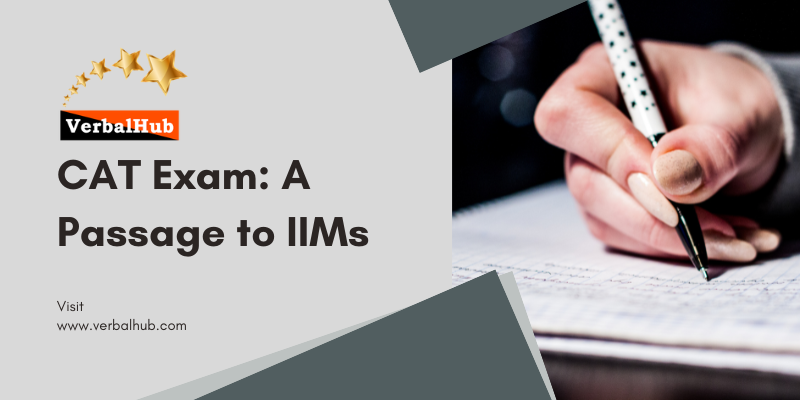

The tone of Reading Comprehension: RC Passage
When preparing for the CAT exam, understanding the tone of reading comprehension passages is crucial for success. The tone of a passage refers to the author's attitude or feelings toward the subject matter, and recognizing this can help you better understand the text's deeper meanings. In reading comprehension for the CAT exam, identifying the tone is a common question type, often found in RC passages. These passages can vary greatly in tone, from optimistic to cynical or humorous to serious. Mastering this aspect of comprehension for the CAT exam will enhance your ability to interpret and analyse complex texts accurately. This page is going to discuss what is the tone of a passage, the types of RC tone, the types of questions of tone in reading comprehension, the meaning of different types of RC tone, prep strategy for Reading comprehension, and the benefit of CAT coaching on verbal ability and reading comprehension for CAT exam.
Reading Comprehension for CAT Exam
The CAT (Common Admission Test) is among the toughest and most competitive exams in India, particularly for students aiming to secure admission to prestigious business schools. Among the various sections of the CAT, the Verbal Ability and Reading Comprehension (VARC) section stands out as both crucial and demanding. Reading comprehension for CAT exam requires focus on understanding the tone of passages to reach the highest percentile in CAT exam.
CAT RC Passage
Reading Comprehension (RC) tests your skill to read, comprehend, and analyze written content. In the context of the CAT exam, CAT RC passages are designed to assess your analytical skills, critical thinking, and ability to infer meaning from complex texts. RC passage for CAT spans a diverse array of subjects, including the humanities, social sciences, technology, and business.
What is The Tone of A passage?
The term “what is the tone of a passage” refers to the author's attitude or emotional stance toward the topic or the readers. The tone of reading comprehension is expressed through the author's selection of language, sentence structure, and stylistic elements. Understanding the tone of reading comprehension helps readers grasp the underlying feelings and perspectives that the author intends to communicate, which affects the interpretation of the text.
Here are some key aspects to consider when determining what is the tone of a passage:
- ⮚Word Choice: The specific vocabulary and language used indicates the author's tone. For example, words like "joyful," "melancholic," "sarcastic," or "critical" carry different emotional weights.
- ⮚Sentence Structure: The manner in which sentences are formed, encompassing their length and intricacy, contributes to the tone of reading comprehension. Brief, abrupt sentences indicate urgency or anger, whereas extended, flowing sentences evoke a more contemplative or descriptive tone of reading comprehension.
- ⮚Imagery and Descriptions: Vivid imagery and detailed descriptions evoke particular feelings and set the tone. Descriptions of bright, sunny scenes create a cheerful tone, while dark, stormy imagery suggests a somber or ominous tone of reading comprehension.
- ⮚Figurative Language: The employment of metaphors, similes, and other forms of figurative language influences the tone. For example, comparing a situation to a "rollercoaster ride" conveys excitement or unpredictability.
- ⮚Context and Subject Matter: The topic itself and how the author approaches it helps determine the tone of reading comprehension. An academic discussion has a formal tone, while a personal anecdote is more informal or conversational.
Note: By analyzing these elements, readers can identify the tone of a passage, which enhances their overall comprehension and interpretation of the text.
Identifying the Tone of a Passage
To determine the tone of RC passage for CAT, pay attention to the choice of words, sentence structure, and the overall mood conveyed by the author. Ask yourself questions like:
- ⯀What is the author's attitude towards the subject?
- ⯀Are there any emotional cues or strong adjectives?
- ⯀Is the language formal or informal?
- ⯀Is there a sense of irony or sarcasm?
For example, if an RC passage in the CAT exam discusses technological advancements with words like "remarkable," "transformative," and "unprecedented," the tone is likely optimistic or enthusiastic.
Examples of Tone Questions
Here are some examples of tone questions you might encounter in the comprehension for CAT exam, along with possible answer options:
Example 1Question: What is the tone of the author in the passage?
- (A) Pessimistic
- (B) Optimistic
- (C) Neutral
- (D) Indignant
Example 2
Question: Which of the following best describes the tone of the passage?
- (A) Celebratory
- (B) Sarcastic
- (C) Cautious
- (D) Euphoric
Example 3
Question: The tone of the author can best be described as:
- (A) Cynical
- (B) Impartial
- (C) Defensive
- (D) Melancholic
Example 4
Question: The tone of the passage is:
- (A) Derisive
- (B) Humorous
- (C) Sympathetic
- (D) Dogmatic
Example 5
Question: The author’s tone in the passage is:
- (A) Nostalgic
- (B) Exasperated
- (C) Arrogant
- (D) Thoughtful
Example 6
Question: Which of the following best captures the tone of the passage?
- (A) Jovial
- (B) Bitter
- (C) Unbiased
- (D) Vindictive
Example 7
Question: What is the author’s attitude towards the subject matter in the passage?
- (A) Respectful
- (B) Skeptical
- (C) Indignant
- (D) Apologetic
Example 8
Question: The tone of the passage can be described as:
- (A) Formal
- (B) Detached
- (C) Amused
- (D) Zealous
Example 9
Question: Which of the following words best describes the tone of the author?
- (A) Optimistic
- (B) Impatient
- (C) Gloomy
- (D) Vindictive
Example 10
Question: The author's tone throughout the passage is:
- (A) Euphoric
- (B) Sympathetic
- (C) Pessimistic
- (D) Ironic
Note: These examples illustrate how tone questions are structured in the CAT exam. The key to answering these questions correctly lies in understanding the passage's context, the author's choice of words, and the overall message or feeling conveyed.
30 Tones of Reading Comprehension for CAT
One of the critical aspects of mastering RC passages for the CAT is understanding the tone of the passage. Tone denotes the author's attitude or viewpoint regarding the subject matter. Recognizing the tone is essential because it can influence the meaning of the passage and the intent behind the author's words. Here are 30 tones of reading comprehension commonly found in CAT passages:
1. Formal: The tone is professional, precise, and free of slang or casual language. Often found in academic or official documents.
2. Informal: The tone is conversational and relaxed, often using colloquial language. Common in personal essays, blogs, or friendly letters.
3. Optimistic: The tone is hopeful and optimistic, indicating a favorable perspective on the subject matter.
4. Pessimistic: The tone is negative or bleak, highlighting unfavorable aspects or potential problems.
5. Serious: The tone is solemn and thoughtful, dealing with important or grave topics in a respectful manner.
6. Humorous: The tone is lighthearted and intended to amuse the reader, often through wit or irony.
7. Sarcastic: The tone is mocking or ironic, often conveying contempt or ridicule through exaggerated or contradictory statements.
8. Critical: The tone is analytical and evaluative, pointing out flaws, limitations, or problems in the subject matter.
9. Sympathetic: The tone shows understanding, compassion, and empathy towards the subject or individuals discussed.
10. Objective: The tone is neutral and impartial, presenting facts and information presented without personal bias or emotion.
11. Subjective: The tone is personal and opinionated, reflecting the author's individual feelings, thoughts, or biases.
12. Encouraging: The tone is supportive and positive, intended to motivate or inspire the reader.
13. Cautious: The tone is careful and restrained, often reflecting concern or the need for careful consideration.
14. Joyful: The tone is cheerful and elated, expressing happiness and positivity.
15. Melancholic: The tone is sorrowful and reflective, often expressing sadness or regret.
16. Detached: The tone is indifferent or unemotional, keeping a separation from the subject matter.
17. Enthusiastic: The tone is excited and passionate, showing strong interest and energy.
18. Ironic: The tone conveys a meaning opposite to the literal one, often for humorous or emphatic effect.
19. Neutral: Unbiased and objective.
20. Admiring: Showing respect or approval.
21. Indifferent: Lack of interest or concern.
22. Cynical: Distrustful of human sincerity.
23. Reflective: Thoughtful and contemplative.
24. Nostalgic: Longing for the past.
25. Regretful: Expressing sorrow or remorse.
26. Didactic: Intended to teach or instruct.
27. Authoritative: Commanding and confident.
28. Defensive: Justifying or defending.
29. Skeptical: Doubting or questioning.
30. Witty: Showing or characterized by quick and inventive verbal humor.
CAT Comprehension: Tips for RC Passages
Practice Regularly: The more you read, the better you become at understanding different tones and styles of writing. Practice with various RC passages for the CAT exam to familiarize yourself with different topics and tones. As RC passage for cat shares almost 70% of verbal ability and reading comprehension for the CAT exam section. Higher percentile of CAT verbal ability and reading comprehension require practice and more than practice.
- o Context is Key: Always read the passage in its entirety to grasp the context before jumping to conclusions about the tone.
- o Focus on Keywords: Identify keywords and phrases that signal the author's attitude. Words like "however," "but," and "nevertheless" can indicate a shift in tone.
- o Summarize: After reading the passage, try to summarize it in your own words. This aids in strengthening your comprehension of the tone and the main ideas.
- o Answer with Precision: When answering questions about the tone of a passage, ensure your answers are precise and supported by evidence from the text.
Verbal Ability and Reading Comprehension for the CAT
The VARC section of the CAT not only tests reading comprehension but also verbal ability that are called verbal ability and reading comprehension for the CAT. Here are some strategies:
- ✓Expand Your Vocabulary: A rich vocabulary helps in understanding and interpreting complex passages.
- ✓Understand Grammar Rules: Strong grammatical skills aid in comprehending sentence structures and identifying errors.
- ✓Practice Parajumbles: Parajumbles or sentence rearrangement questions test your ability to logically sequence sentences. Regular practice can improve accuracy and speed.
- ✓Read Diverse Material: Expose yourself to a variety of reading materials, including newspapers, journals, fiction, and non-fiction. This broadens your understanding and adaptability to different writing styles.
Note: Mastering reading comprehension for the CAT exam involves more than just reading and answering questions. By recognizing the various tones and practicing regularly, you can significantly improve your performance in the Verbal Ability and Reading Comprehension section. Stay consistent with your practice, focus on your weak areas, and keep a positive attitude throughout your preparation journey.
CAT Coaching for CAT Exam
Enrolling in CAT coaching for CAT exam preparation offers several benefits, thus join any CAT coaching to enhance your performance in CAT exam:
- o Curriculum: Coaching centers provide a well-organized and systematic study plan, covering all essential topics and ensuring comprehensive preparation.
- o Faculty: Gaining access to seasoned instructors who can offer expert advice, clear up uncertainties, and provide valuable insights into exam patterns and strategies.
- o Regular Practice Tests: Frequent mock tests and practice sessions help Students become acquainted with the exam format, enhance their time management abilities, and evaluate their progress.
- o Personalized Attention: A multitude of coaching institutes provide tailored, one-on-one attention and mentoring, helping students identify and work on their weak areas.
- o Study Materials: Access to high-quality study materials, including books, notes, and online resources, tailored specifically for the CAT exam.
- o Peer Learning: Being part of a group of aspirants fosters a competitive environment and encourages peer learning, sharing of ideas, and collaborative problem-solving.
- o Discipline: Regular classes and a structured schedule help maintain discipline and keep students motivated throughout their preparation journey.
- o Doubt Clearing Sessions: Specialized doubt-clearing sessions guarantee that students can have their questions answered swiftly and continue their preparation without any hurdles.
Note: Overall, CAT coaching solidifies the effectiveness of CAT exam prep and assure you improve your chances of success in the exam.
Our Teachers

Dr. G Ravindra Babu
Quant Faculty
Ph. D in Mathematics Asian International University|| Mathematics Professor at Gitam University || Ex-Mathematics Professor SRM University Amaravathi || MBA in finance Acharya Bangalore B School || GMAT Quant 51, CAT Quant 99.58 %tile, GRE Quant 170 || 21 Different Teaching Certification || Believe in “Education is the mother of leadership”
view details

Dr. Rengarajan Parthasarathy
CAT Faculty
Ph. D in Mathematics from YCM University|| Mathematics Professor at Symbiosis International|| Author of Business Ethics || Ex-CAT Exam Syllabus Advisor in IIM || MBA & MPM from Symbiosis International (Deemed University) || College Topper in Mathematics in Ferguson College || Six Scholarships in Mathematics || 15 Years CAT Coaching, GMAT Coaching and GRE Coaching Experience|| UGC NET Qualified || GMAT Q51, V38 & CAT Q 99.31 & DILR 99.38 %tile, GRE Quant 170 || Believe in “Higher Education Shapes The World.”
view details

Dr. Nisha Tejpal
Verbal & AWA Faculty
Ph. D in English || Published a paper in English in ‘Research Journal of Philosophy and Social Sciences’ || MCA and B.Ed CCS University || A subject expert in Verbal Teaching || 10,000 Plus Essays Analysis || CTET and NET Qualified || More than 15 years of Experience || A writer, Author and Poet || Believe in “Think Beyond the Universe”
view details

Dhrithi Khattar
Verbal Faculty
A subject expert in Verbal Aptitude || More than 15 years of Experience || MBA in HR& Marketing & MA in Economics || Active Member of Hindu Alumni Association || Functional Member of Delhi ||Management Association (DMA) || Operational Member of All India Management Association (AIMA) ||The President of Key Club ||An active member of the French Club ||Gold Seal from California Scholarship Federation.
view details
M. U. Mir
DILR & Quant Faculty
A subject expert in Quantitative Aptitude Training || GMAT Q 51 & CAT DILR 99.75 %tile || GATE 2020 Qualified || M. Tech & B. Tech University Toper (1st Rank) || Awarded by Gov of Odisha, Bihar and J& K for the project Magnetic Floating Model || Ex-Quant Subject Expert in Arihant Publication || An Educationist and Social Worker || Believe in “Education is power”
view details

C. S. Rajawat
CAT Faculty
M. A in Mathematics CCS University|| M. Tech from SRM University || Visiting Mathematics Faculty CCS University ||Experience of 11 Years of CAT Coaching || District Topper in 10th & 12th || Best Teacher Awardee in 2021 & 2022 || CAT Quant 99.43 %tile || Discovered a new Theorem based on HCF in Math || Founder of C. S. Classes ||Believe in “Teaching and Training is an Art.”
view details
Dr. S.K. Singh
PTE/IELTS/CELPIP Expert
Ph. D. English Dr. B. R. Ambedkar University || Delhi & Center Government School Mentor || Founder of Entrepreneur & Learning Startup || IELTS & CELTA Certified from British Council || PTE Certified from Pearson...
view detailsRishabh Arora
PTE/IELTS/CELPIP Expert
MBA in HR International Institute of Management Sciences || PTE Certified from Pearson Test of English|| IELTS & CELTA Certified from British Council || BCA from Integral University || PTE 87 in 2017, IELTS 8.5 in 2018
view details
Jyoti Joshi
IELTS Trainer
Master in English (MA) and Bachelor in Education (B.Ed) || Certified Trainer || IELTS Speaking 9.0 Band holder || Believe in “Great teacher can inspire hope, ignite the imagination, and instill a love of learning”
view details
Surbhi Arora
IELTS / PTE Expert
English Language Expert || More than 3 years of Experience || M.A plus B. Ed Delhi University ||Author, Writer & Classical Singer|| Believe in “Language Language Learning & Teaching is Fun”
view details

Dilip Kumar Rathore
Quant Trainer
A business developer and genius in mathematics || Highly experienced || Master in Maths || well-verse in IT || Believe in “The art of teaching is the art of assisting discover”
view details

Imaam Hasan
Communication Expert
Master in English || Journalist and writer || Certified IELTS & PTE Trainer || A social educater and influencer || Believe in “Education is the movement from darkness to light”
view details










